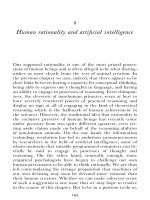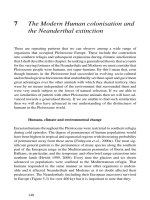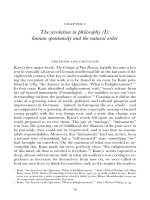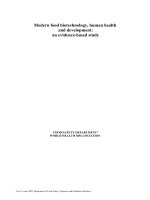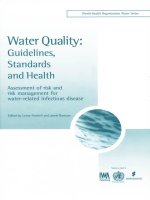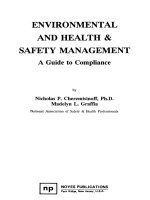Human health and ecological risk assessment and risk management
Bạn đang xem bản rút gọn của tài liệu. Xem và tải ngay bản đầy đủ của tài liệu tại đây (3.33 MB, 61 trang )
Introduction to course
Tuesday December 6 09.00
Herman Autrup
Professor, PhD, Fellow ATS
Human Health and Ecological Risk
Assessment and Risk Management
1
Course Coordinator: Khunying Mathuros
Ruchirawat
Objectives: Give an introduction to the assessment of
risk of chemicals to human health and well-being and
the environment, and present the newest concepts in
the evaluation of risks
Format: Lectures including case studies, and risk
assessment exercise, special feature Presentation of
IPCS/WHO Risk Assessment Toolkit
Teaching material: Hand-outs of power-point
presentations, and additional material provided by the
lecturers
2
INTERNATIONAL FACULTY:
Herman Autrup, Professor School of Public
Health University of Århus Denmark
Len Ritter, Professor Canadian Network of
Toxicology Centres, University of Guelph,
Canada
Martin van den Berg, Professor Institute of
Risk Asssessment Sciences, University of
Utrecht, The Netherlands
Mary E. Meek, McLaughlin Center for
population Health Risk Assessment, Ottowa,
Canada
Kerstin Gutschmidt, WHO, Geneva
3
LECTURES:
Give the theoretical background for risk
assessment
General human and eco-toxicology
Tools used in risk assessments
Animal studies
Human studies
Exposure assessment
Mode of Action
Standard setting
Management and communication
4
RISK ASSESSMENT EXERCISE
Flameretardents – PBDE
Mercury
Arsenic
Water disinfection
Parabenes
Benzen
5
Friday, December 16
Presentation of Risk Assessment Exercise – 30
min each group, allow 5 min for questioning
and discussion
Examination for graduate students:
January - 6 hrs written examination, questions
prepared by all the international faculty -
members
6
???
7
Toxic Effects of Chemicals
Tuesday December 6 09.15
Herman Autrup, Professor, PhD
8
GENEREL INTRODUCTION
TOXICOLOGICAL PARADIGME
MECHANISTIC TOXICOLOGY
DESCRIPTIVE TOXICOLOGY
RISK ASSESSMENT
STRUCTURE OF LECTURE
9
LIVING IN A CHEMICAL WORLD
Man-made and natural
Approx 60.000 chemicals in use
Only 1500 chemicals account for 95% of the
production (HPV)
Covers 11 mill different products
10
GEOGRAPHIC BREAKDOWN OF
WORLD CHEMICALS SALES
11
WHY WE SHOULD LEARN
TOXICOLOGY ?
We are
Syntetic
Natural
We are surrounded by to a complex group of chemicals –
exposed via different routes
12
CHEMICALS IN THE ENVIRONMENT
Home – use of products
Workplace – production of chemical
and manufacturing of product
General environment – indirect exposure
Misuse of chemicals
13
WHAT IS TOXICOLOGY?
• Toxicology helps
create a safer world
• Definition: The study
of the negative
effects of chemical
and physical agents
on living organisms
• Modern toxicology
uses chemicals as
tools to understand
molecular/cellular
biology
Toxicology is the art of
identifying the unexpected
15
• Toxicology is arguably the oldest
scientific discipline, as the earliest
humans had to recognize which
plants were safe to eat.
• Humans are exposed to chemicals
both deliberately and inadvertently.
Most exposure of humans to
chemicals is via naturally
occurring compounds consumed
in the diet from food plants.
TOXICOLOGY AFFECTS US EVERYDAY
California Wants to Serve a Warning With
Fries (NY Times, Sept 21, 2005)
Fish-mercury risk underestimated
(CNN.com, Apr 12, 2001)
Ephedra Ban: What Took So Long?
(CBSNews.com, Dec 30, 2003)
Aluminum-plant Hungary, Oct 2010
17
Nov. 5, 2004 © AP Images/Sergei SupinksyJuly 3, 2004 © AP Images/Anatoly Medzyk
VIKTOR YUSHCHENKO:
POISONED BY DIOXIN
18
ALL SUBSTANCES ARE POISONS, THERE IS
NONE WHICH IS NOT A POISON. THE RIGHT
DOSE AND TIMING DIFFERENTIATES A
POISON FROM A REMEDY.
Modification of Paracelcus
Father of Modern Toxicology
Areolus Phillipus Theophrastus
Bombastus von Hohenstein
Paracelsus 1493-1564
19
TOXICOLOGICAL PARADIGM
Exposure
Internal
Dose
Biologically
Effective
Dose
Early
Biological
Effect
Altered
Structure &
Function
Disease
Absorption
Distribution
Metabolism
Excretion
Storage
Toxicokinetics
Toxicodynamics
What We do to the Chemical
What the Chemical Does to Us
Susceptibility and
Modifying Factors
(Genetics and Nutritional Status)
20
EXPOSURE DOSE TARGET DOSE
Biological
effect
Level 1 defence:
uptake
Level 2 defence:
Biotransformation
Distribution
Level 3 defence:
Cellular
defencesystems
TOXICOKINETICS
21
LEVEL 1 - DEFENCE
PROPERTIES OF CHEMICALS
LIPID SOLUBILITY
IONISATION
SIZE of MOLECULE
PHYSICAL FORM
CONTACT POINT
SSKIN, LUNG, GI
Physical barrier, blood circulation
22
GASTROINTESTINAL TRACTS
Exposure: Diet and water
Macrophage engulfed particles
Dose depends on level of contaminants in source
Risk assessment: How much is taken up – dose –
default 100%
Transport via blood and lymph to liver
Factors controlling uptake:
Lipid solubility
Degree of ionization
Size of molecule
pH
23
UNBORN CHILD - PLACENTA
• Lipid solubility
• Molecule size
• Ionisation
24
UPTAKE-DISTRIBUTION
Local and Systemic toxicity
25
